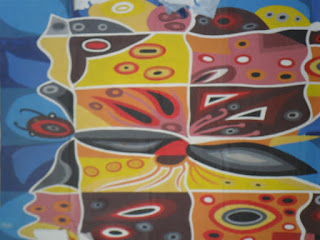Thursday, January 31,
2013
Thies or Bust
How many ways are there to get to Thies? And, why would you go? These are questions we answered on Thursday.
Thies, pronounced “chess”, sort of, is the second largest
city in Senegal and is about 70 km east/northeast of Dakar. It’s known as a world class tapestry and rug center,
and the guide books speak of its beautiful tree lined streets and colonial
architecture. It was on our list of
places to go in Senegal from day one.
But, how to get there and back? The guide book says take the train or a
taxi. Anybody can take a taxi all the
way, but locals don’t. Sineta, our
B&B host, says the train is not a way? How do locals get there? The owner of the place we had breakfast
suggested in broken English that we take the #36 bus to Dor (wherever that is)
and then take a clando (one of the junker cars that ride up and down the road;
you flag them down and pay a small fee for short distance transportation) to
garage Pikin where we would board a collective (4 to7 passenger) car bound for
Thies. On the outskirts of Thies we
would debark the collective and hop aboard a local taxi for the 3 km trip to centreville. All very simple, if you speak French and understand
Wolof.



We chose a middle of the road option. We took a taxi straight from the breakfast
restaurant to garage Pikin and boarded a 4 passenger collective to Thies where
we took the local taxi to the center of town.
No sweat.
In centreville, we
wandered for ten minutes to be sure we had no idea which way to go. But, talk about dumb luck, at that point a
180 degree spin revealed the big “i”,
the Office of Tourism.
There, Aminata, was holding down the fort. She made the required reservations for us at the
MSAD, Manufacturers Senagalaise des Arts Decoratifs. She then attempted to find a guide for us but
could not, so she locked the office door and accompanied us for the next four
hours.
Two hours in the MSAD, including a private three-way shared lunch
in the staff room and an introduction to the Director General, left and
impression of this place as first class.
Tapestries are designed and made here based on paintings selected by
competition. Only eight tapestries are
made based on any one painting. It’s
very hard to get a painting chosen. Some
of the tapestries hang in the UN, in embassies around the world, in large
hotels and financial institutions, and in private collections. All are for sale. Photos of the tapestries were not allowed.
However, exquisite hand knotted rugs are also produced at the
MSAD. These we could photograph during
production, so we did.
The famed tree lined streets of town were “street” of town
and it is called the “street without light”.
If it were not paved with sand, and the buildings did not look like they
were all falling down, and it were a whole lot cleaner, it could remind you of
southern France if your eyes were closed.
This reason to visit should come out of the guide books in my opinion. But they do have a nice calabash tree at the MSAD.
Aminata helped us get to a small roadside village about 7 km
out of town to buy some baskets. It’s a “Catholic”
village that hosts a big basket market on Mondays. Being Thursday, the selection was limited but
plenty big enough for us.
From there, the trip back to
Dakar was much the same at the journey from Senegal, the exception being that
the traffic was worse, the collective
car was an old jalopy, and the crowd noise and pressure at the garage outside Thies was too, too
intense. Sandy has sworn off collectives and the garages associated with them.
Tomorrow is our last full day in
Senegal.

















No comments:
Post a Comment